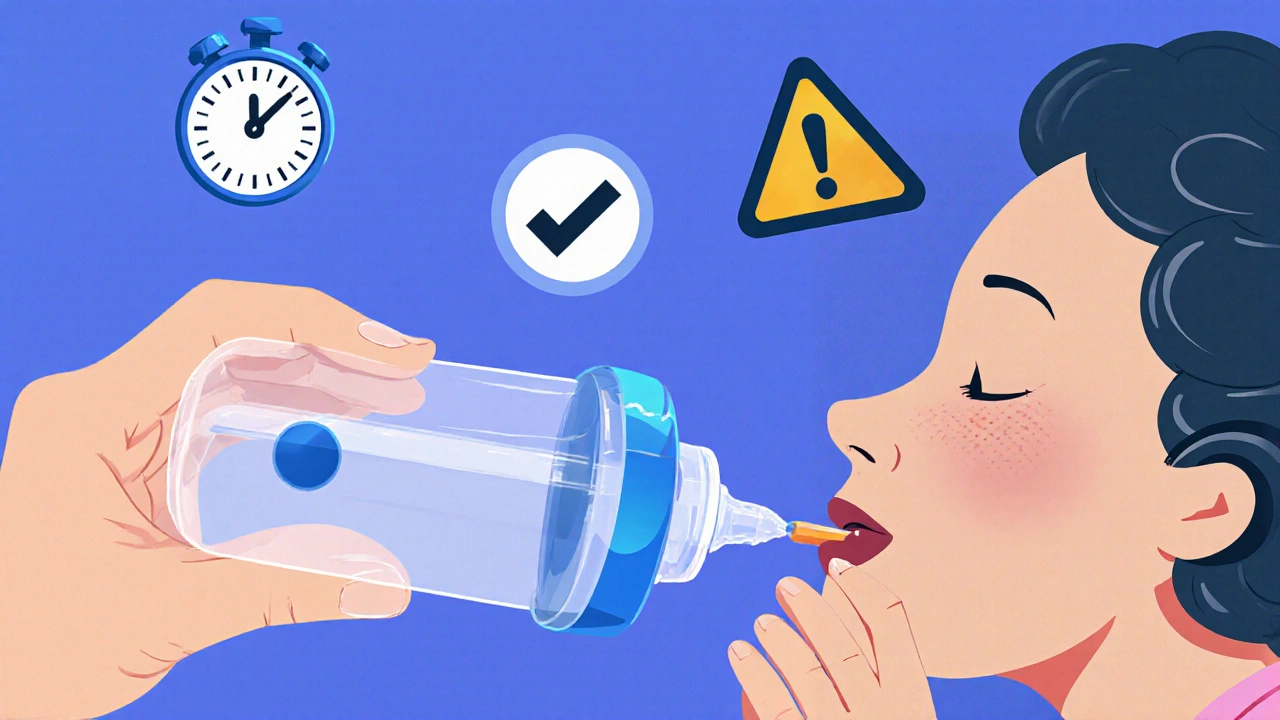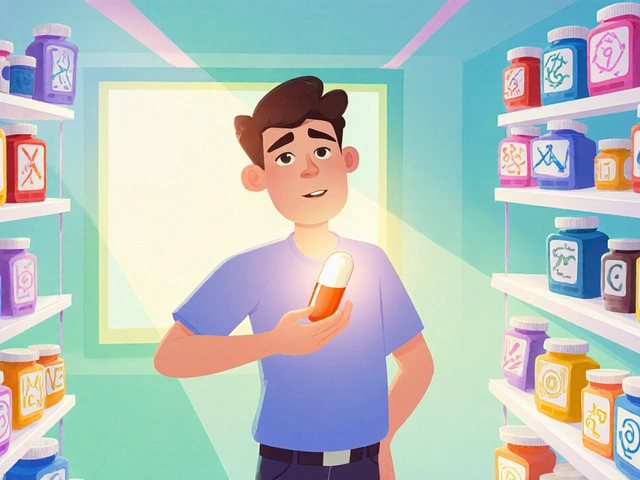Liquid Medication Dosing Calculator
Calculate Your Dose
Visual Dosing Aid
Dosing Results
Getting the right dose of medicine isn’t just about following the label. It’s about seeing it clearly-especially when you’re giving medicine to a child, an elderly parent, or managing it yourself under stress. A wrong drop, a misread line, or a rushed guess can turn a safe treatment into a dangerous mistake. That’s why visual dosing aids-syringes, droppers, and measuring cups with clear markings, color zones, and simple designs-are no longer optional. They’re a critical part of any safety plan.
Why Visual Dosing Matters More Than You Think
Think about the last time you had to measure liquid medicine. Maybe it was for your toddler’s fever reducer or your grandparent’s blood pressure syrup. You fumbled with the cap, squinted at the tiny lines, and wondered: Is that 2.5 mL or 3? You’re not alone. Studies show that up to 40% of dosing errors with liquid medications happen because people misread measurements. These aren’t just small mistakes-they lead to hospital visits, overdoses, and sometimes worse. Visual dosing aids were developed to fix this. They don’t rely on math. They don’t ask you to remember conversion charts. They show you exactly where the dose ends. One study from 2018 tested radiologists in emergency simulations using epinephrine during a contrast reaction. Those using visual dosing tools made errors in only 18.2% of cases. Those without? 40%. That’s more than half the error rate gone. And it’s not just about accuracy. It’s about speed. In an emergency, every second counts. With visual aids, the average time to give the right dose dropped from 152 seconds to 97 seconds. That’s over a minute saved-time that could mean the difference between recovery and crisis.How Syringes Are Designed for Safety
Not all syringes are created equal. The ones you pick up at the pharmacy might look simple, but the best ones for medication safety have features you can’t miss.- Enlarged, high-contrast markings: Instead of tiny lines, the dose levels are bold and easy to read, even in low light.
- Color-coded zones: Green for safe dose, yellow for caution, red for danger. No guessing.
- Simplified scales: Only show the doses you actually need. No 0.7 mL or 1.3 mL lines-just 1 mL, 2 mL, 3 mL. Less clutter, fewer mistakes.
- Plunger stops: Some syringes have a built-in stop that prevents you from pulling too far, avoiding accidental overdoses.
Droppers That Don’t Lie
Droppers are common for babies and small doses. But standard glass droppers? They’re terrible for accuracy. The liquid clings to the sides. The drops vary in size. You never know if you got one full drop or three. Modern visual droppers fix this with:- Transparent measurement windows: You can see the exact volume as you fill it.
- Colored indicators: A ring or band changes color when you’ve reached the correct dose.
- Calibrated tips: Each drop is standardized to 0.05 mL or 0.1 mL, so you can count confidently.

Measuring Cups and Spoons: The Quiet Heroes
For older kids and adults, measuring cups are often the go-to. But kitchen spoons? Don’t use them. A teaspoon from your drawer can hold anywhere from 3 mL to 7 mL. That’s a 130% variation. Visual measuring cups are marked in milliliters, not teaspoons or tablespoons. They have:- Wide, non-slip bases for stability
- Spouts for easy pouring without spills
- Clear, raised numbers you can read from any angle
What the Research Really Says
The data is clear. In a study of 138 healthcare workers using visual dosing aids during simulated emergencies:- 97.8% said the visual tool made them feel more confident in their dose
- 87% said it reduced the time to give the medication
- Errors dropped by more than half compared to traditional tools
How to Choose the Right Tool
Not every visual dosing aid works for every situation. Here’s how to pick:- For infants and small children: Use a calibrated dropper with color indicators. Avoid syringes unless you’re trained-they can be too fast.
- For toddlers and older kids: Use a dosing syringe with a wide plunger and color zones. Avoid cups if they’re likely to spill.
- For adults managing daily meds: Use a measuring cup with a dosing cap. If you’re on blood thinners or epilepsy meds, get one with milliliter-only markings.
- For emergencies: Make sure your home kit includes a visual epinephrine syringe if prescribed. Know where it is. Practice with a trainer.

Training and Practice Are Still Needed
Even the best tool won’t help if you don’t know how to use it. A 2018 study found that people who practiced with visual aids once-just once-made far fewer mistakes than those who didn’t. Here’s what to do:- Ask your pharmacist to show you how to use your new syringe or dropper. Do it in front of them.
- Practice with water. Fill it to the line. Pour it out. Do it three times.
- Keep the tool with the medicine bottle. Don’t store it in a drawer.
- Teach anyone else who gives medicine-grandparents, babysitters, caregivers-how to use it.
What’s Next for Visual Dosing?
The future is already here. Some new tools have QR codes you scan to hear a voice tell you the dose. Others connect to apps that log when medicine was given. But the core idea hasn’t changed: make it simple. Make it visible. Make it impossible to get wrong. In New Zealand, hospitals and community pharmacies are starting to give out visual dosing kits with every liquid prescription for children and seniors. It’s not mandatory yet-but it should be.Final Thought: Safety Isn’t an Option
Medication errors are one of the leading causes of preventable harm. And most of them happen because someone couldn’t see the dose clearly. Visual dosing aids don’t promise perfection. But they give you a fighting chance. If you’re giving medicine to someone you love, don’t guess. Don’t estimate. Don’t hope. Use a tool that shows you the answer. It’s not about being perfect. It’s about being safe.Are visual dosing aids only for kids?
No. While they’re especially helpful for children because dosing is based on weight, visual dosing aids are just as important for older adults, especially those on multiple medications or with vision problems. Seniors are at high risk for dosing errors due to confusion, memory issues, or difficulty reading small print. Visual tools reduce that risk for everyone.
Can I use a kitchen spoon if I don’t have a measuring tool?
Never. Kitchen spoons vary wildly in size. A teaspoon can hold anywhere from 3 to 7 milliliters. That’s a 130% difference. One study found that using kitchen spoons for medication led to overdoses in 40% of cases. Always use a proper dosing tool-even if it’s just a plastic syringe from the pharmacy.
Do I need to buy expensive tools?
No. You don’t need high-tech gadgets. Basic visual syringes and droppers cost under $5 and are often provided free by pharmacies when you pick up liquid prescriptions. Look for clear markings, color zones, and milliliter units. Avoid anything with tiny, hard-to-read lines.
Why do some visual aids still have errors?
Because tools don’t replace training or attention. The most common error in studies wasn’t misreading the syringe-it was giving the medicine to the wrong person, by the wrong route, or too quickly. Visual aids reduce measurement mistakes, but they can’t fix confusion, distraction, or poor communication. Always double-check the name, dose, and route before giving anything.
Where can I get visual dosing tools?
Ask your pharmacist. Most pharmacies in New Zealand now stock visual dosing syringes, droppers, and cups at no extra cost when you fill a liquid prescription. You can also buy them at medical supply stores or online retailers that specialize in home healthcare products. Look for brands like BD, Medline, or Neogen, which are commonly used in hospitals.











Scott Macfadyen
Just used one of those color-coded syringes for my kid’s antibiotics last week. Honestly? Life-changing. No more squinting at tiny lines while half-asleep at 3 a.m. The green zone actually made me feel like I wasn’t about to poison my own child. Why isn’t this standard everywhere?
Jonathan Gabriel
the fact that we still have to rely on visual aids instead of just... i dunno, making the meds easier to dose without them is wild. we’ve got AI and self-driving cars but we’re still counting drops like it’s 1987. also, ‘medication-grade’ is just marketing speak-most of these are just plastic with better fonts. but hey, if it stops someone from giving 10ml instead of 5, i’ll take it. 🤷♂️
Alex Czartoryski
Oh wow, so now we’re medicating people with rainbow syringes? Next they’ll be singing lullabies when you inject insulin. This is what happens when you let safety engineers design medicine instead of doctors. Also, I’ve used kitchen spoons for 20 years and my grandma’s still alive. Coincidence? I think not.
Gizela Cardoso
I work in home care and we hand out these visual tools to every new client on liquid meds. The difference is real. One elderly man cried because he finally didn’t have to ask his daughter every time he took his blood pressure med. It’s not about fancy tech-it’s about dignity. Simple tools = less shame.
Denise Cauchon
Canada’s the only country that gives these out for free?? 😭 I’m so proud. Like, we’re not just surviving healthcare-we’re *designing* it with empathy. Meanwhile, my cousin in Texas had to buy a syringe online because her pharmacy said ‘we don’t stock those.’ America, why are you like this?? 🇨🇦💙
Victoria Malloy
My mom’s on six different liquids. I got her a dosing cup with the cap that screws on. She hasn’t spilled one drop since. I just wish we could get them in every pharmacy without having to ask. It’s not a luxury-it’s basic care.
Chloe Sevigny
One might argue that the proliferation of visual dosing aids reflects not an advancement in pharmacological precision, but rather a systemic failure of medical literacy and cognitive ergonomics. We are, in essence, compensating for institutional neglect by externalizing cognitive load onto the patient. The color-coded syringe is not a solution-it is a symptom. A beautifully engineered symptom, yes, but symptomatic nonetheless. The real question: Why are we still prescribing liquid medications to populations with demonstrable visual or cognitive impairments without built-in safeguards? The tool doesn’t fix the system. It just makes the system less visibly catastrophic.
Andrea Johnston
My aunt took her grandkid’s medicine by accident last month because she grabbed the wrong bottle. She thought it was her blood pressure stuff. The syringe was right there. On the counter. In the same color zone. She just... didn’t see it. Tools don’t fix distraction. They don’t fix grief. They don’t fix forgetting. You can have the most beautiful dosing cup in the world-but if your brain is full of worry, it won’t help. I’m not saying don’t use them. I’m saying: don’t pretend they’re magic.
Don Angel
Can we please stop pretending that ‘milliliter-only markings’ are some revolutionary breakthrough? I’ve been using ml since I was 12. Also, the phrase ‘medication-grade’ is a scam. It’s plastic. It’s not a lab instrument. Also, why is no one talking about how these tools are often made overseas with zero quality control? I’ve had droppers leak. I’ve had syringes stick. I’ve had color zones fade after two weeks. You want safety? Train people. Don’t buy cheap plastic.
Bruce Bain
My grandma in Ohio used a kitchen spoon for 15 years. She’s 92. Still walks. Still bakes. Maybe we’re overcomplicating this.